Eliette Markhbein
New York, United States
My show, WHACK’ed . . . and then everything was different, honors traumatic brain injury (TBI) survivors who changed perceptions of TBI and disability and became role models for millions. The series of large scale portraits personify the various causes of TBI as well as the diversity of people it affects. The portraits include those of rock and movie stars Keith Richards and George Clooney, as well as Congresswoman Gabrielle Giffords, ABC-TV news correspondent Bob Woodruff, retired ARMY SPEC Claudia Carreon (a veteran of the Iraqi war), Hall of Fame athletes Troy Aikman (NFL) and Pat Lafontaine (NHL), Alexis Verzal (a very spirited 5-year-old who was shaken and thrown into a wall at age 2), Trisha Meili (the “Central Park Jogger”), and Timothy Pruce (New York Brain Injury Association Vice-President). The concept and formalism of my work is informed by my personal experience with traumatic brain injury and evokes the need to reassemble fragments of a pre-existing identity in order to create a new self. Thus the drawing, cutting, and collage technique used throughout the series is a reflection and a silent testimony to the three phases of traumatic brain injury: Fractured, Reassembled, Whole.
First drawn in charcoal on paper based on photographs cropped to desired intimacy, the images are then imperfectly cut with scissors into squares and reassembled as portraits on painted canvas. I use paper to draw the portraits because like a human being, paper is organic, resilient, and fragile. It bends, absorbs, and rips; and bears witness to its endurance by exhibiting its scars in the process.
Each portrait is organized in a grid formation that reflects both an inward and outward representation of TBI. The uneven grid effect resulting from the drawing, cutting, and collage technique illustrates how TBI disrupts sensory and perceptual processes (such as the seamless way the mind functions pre-injury—a phenomenon one is unconscious of until it is lost) and substitutes it with jagged awareness and fractured perceptions. The grid also acts as a metaphor for the support and structure TBI survivors require in order to live a productive and rewarding life. Like the philosopher Emmanuel Levinas, I believe the face is not only the outward sign of a personage, but the naked essence of humanity. As such, it reveals an extraordinary vulnerability and an astonishing resilience. By representing faces of TBI survivors on a large scale, I hope to elicit emotional intimacy and universality.
I want my work to raise awareness of Traumatic Brain Injury so the public better understands its symptoms and is more prepared to support injured soldiers returning from Iraq and Afghanistan, as well as their families, as they transition and adapt to a new life.
Based on my experience as an artist-in-residence at The Mount Sinai Rehabilitation Center in New York and the success of using art as a modality for the rehabilitation of TBI patients, I have partnered with the Brain Injury Association of America and the Society for Arts in Healthcare to educate the public and raise awareness about TBI. The portraits will tour the country and be auctioned after the touring exhibit to raise funds to support an Artists-in-Residence program to serve people with TBI in hospitals and rehabilitation facilities throughout the United States.
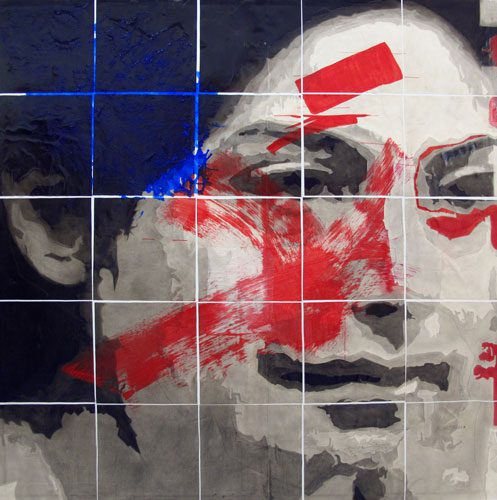
72” x 72”
Kept on active duty after her accident, Claudia was demoted for not obeying orders. Due to her TBI, she could not remember orders. She cannot remember either being pregnant, giving birth, or being a mother. Claudia is one of more than 320,000 service-members having sustained a TBI in the Iraq and Afghanistan wars.
“I indeed don’t remember how I was injured, but I know that living with TBI can be complicated at times. TBI has shaped my life in a whole different way than anybody else, and also has brought me knowledge and recognition from people that I would never think of. The daily thought of how blessed I am to still be around — to have the opportunity to live in the company of my beautiful children, mother, siblings; to be able to walk, run, go up and down the stairs, talk, laugh, see, think on my own, love, and many, many more things that are gifts given to us, no questions asked, by the Almighty God — yet some of us as human beings tend to take them for granted and forget the purpose of life.” —Claudia Carreon

60” x 42”
“In August 1994, one week before my 34th birthday, my life as I knew it changed dramatically when I was in a car accident and suffered a traumatic brain injury. The 10-second accident took away 34 years of who I had become and all that I had achieved, but have also given me 17 years to become a different person with new insights and achievements. When I was first taken to the hospital, I was suffering from partial paralysis on my right side, so nobody paid any attention to my head injury. My head had lurched forward and hit the steering wheel and snapped back and hit the head rest. When I regained consciousness, my processing was very slow, my short and long term memory severely affected and I was very disoriented most of the time. It was the physical therapist who was treating me for the paralysis at the time who recognized my deficits and referred me to a brain injury specialist. I still have all the deficits I initially sustained from that accident 17 years ago, but they are less pronounced and I have learned to adapt and compensate for them. I live and deal with my brain injury on a daily basis, it is part of who I am now and it has helped motivate me to become a patient and caring father, husband, friend, and advocate. My hope is that my journey and example can help motivate others, and show that life goes on after sustaining and living with a TBI.” —Timothy Pruce (www.bianys.org)
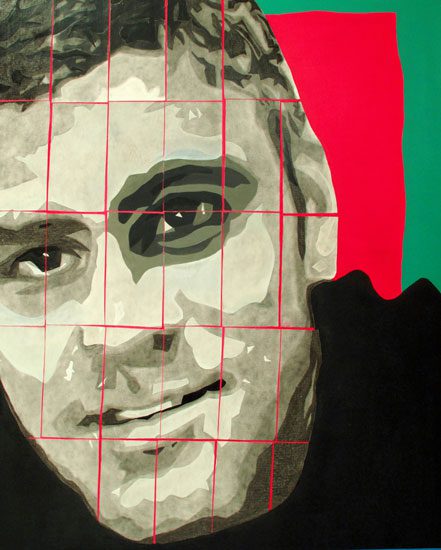
60” x 48”
As reported in various newspaper articles, George Clooney revealed how he contemplated suicide to escape the horrific pain he was experiencing after suffering a brain injury in an accident while shooting a scene for Syriana. The 44-year-old star said he battled against excruciating headaches and serious memory loss after falling and banging his head while filming the thriller set in the Middle East.“There was this scene where I was taped to a chair and getting beaten up. The chair was kicked over, and I hit my head. I tore my dura, which is the wrap around the spine that holds in the spinal fluid. I basically bruised my brain. It’s bouncing around my head because it’s not supported by the spinal fluid,” Clooney stated. He suffered constant pain and splitting headaches as doctors initially could not identify the problem. He could not take painkillers in case he became addicted to them; several members of his family had suffered that fate. Instead, he had to prepare mentally through therapy that taught him to forget his own pain. After the accident, Clooney began trying to encourage his memory to return by doing repetitive counting exercises, and even had to write his lines on scraps of paper for his next project. “TBI has been a big issue in my life, it changed everything for me” he says, and he has the scars to prove it. “It starts from the top of my neck and goes all the way down to the base of my spine. I still have to have blood patched right into my spine to try and clog up the holes . . . that hurts. Every day I still have to deal with pretty severe headaches, but nothing like what it was.” —George Clooney (www.thebettyclooneyfoundation.org)

66” x 72”
Keith Richards underwent surgery to relieve a subdural hematoma on his brain from falling 16 feet from a palm tree while gathering coconuts during his vacation in Fiji. He reportedly lost his grip while climbing a tree with his fellow band member, Ronnie Wood, at the exclusive Wakaya Club resort. As was widely reported by the media, Keith Richards said, “Drugs I’m on now — the shit I’ve gotta’ take because of the brain job. Dilantin means you can’t take cocaine anymore, which is fine with me. I mean, I haven’t seen coke for, like, a year and a half. Big deal. Y’know, I used to like my little bump here and there after meals, but now I can’t do that anymore. I still smoke like a chimney. Get me some good weed.”

84” x 60”
On January 8, 2011, Gabby Giffords was the victim of a shooting near Tucson, Arizona, at a supermarket where she was meeting publicly with constituents. She was critically injured by a gunshot wound to the head; 13 people were injured and six others were killed in the shooting. Gabby Giffords was later brought to a rehabilitation facility in Houston, Texas, where she recovered some of her ability to walk, speak, read, and write. On May 16, 2011, Gabby Giffords traveled to Kennedy Space Center to watch the launch of STS-134, the final flight of Space Shuttle Endeavour, which was commanded by her husband Mark Kelly. From space, Mark flashed homemade cards to Gabby, spelling “Beautiful.” On January 22, 2012, Gabby Giffords announced that she would resign from her congressional seat in order to concentrate on recovering from her wounds, but promised to return to public service in the future.
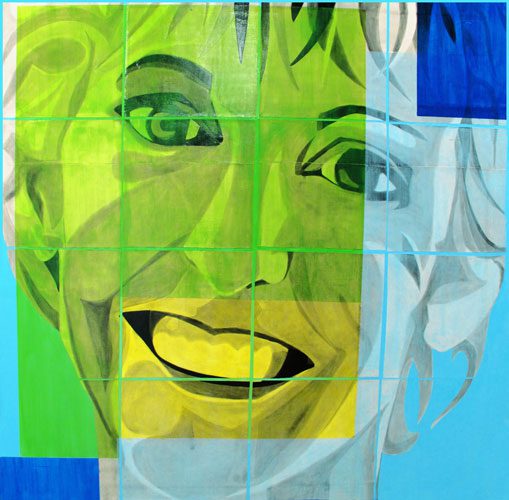
60” x 60”
“I am the author of the best-selling memoir, I Am the Central Park Jogger: A Story of Hope and Possibility. My story is about resilience and the capacity of the human body and spirit to heal. It didn’t begin that way. On April 19, 1989, I went for a run in New York City’s Central Park shortly after 9pm. Hours later, two men wandering the park found me near death from a brutal beating and rape. In a coma, with 80 percent blood loss, a traumatic brain injury, and severe exposure, doctors at Metropolitan Hospital worried that I might not survive. The story seized the headlines, not only in New York, but also around the world as people contemplated what the savagery of the attack said about our society. Today I speak to groups, including businesses, universities, brain injury associations, sexual assault centers and hospitals, about my journey of recovery and healing; about how I responded to my personal tragedy by shifting my thinking and actions, allowing me to move from victim to survivor, reclaim my life, and become whole. With my work, book, and lectures, I offer lessons on how to manage through unpredictable change, whether personal, professional, economic, or spiritual. My story has encouraged people worldwide to overcome life’s obstacles — regardless of what they might be — and get back on the road to life.” —Trisha Meili (www.centralparkjogger.com)
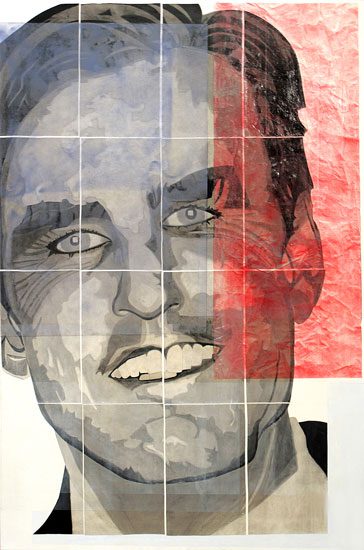
72” x 48”
On January 29, 2006, 27 days after he was tapped to succeed Peter Jennings as the co-anchor of ABC World News Tonight, Bob Woodruff was nearly killed by a roadside bomb explosion, which struck his vehicle while on assignment near Taji, Iraq. The blast knocked Woodruff unconscious as rocks and metal pierced his face, jaw, and neck. Woodruff’s cameraman, Doug Vogt, and an Iraqi soldier were also hurt. “How I survived, we still don’t know to this day,” he says. And when he survived, no one thought he would be able to work again—especially as a broadcast journalist. But Bob did return to the air, 13 months after getting injured, to tell his story in a documentary called To Iraq and Back: Bob Woodruff Reports. The journey back was not easy. Immediately after the attack, Woodruff was placed in a medically induced coma for 36 days so his brain could rest and heal. Upon waking up, he recalls, “I could not remember my family members’ names. I remembered [my wife] Lee and two of my kids. I could not remember my twins’ names. I did not even remember having twins.” After that came multiple surgeries—he estimates about nine. Woodruff’s physical skills came back relatively quickly, but it took intense cognitive rehabilitation to regain some of the skills he had lost. Bob Woodruff also suffered from aphasia, the inability to find words. “I couldn’t come up with words, and I didn’t have a lot of synonyms,” he says. “It was hugely frustrating.” To this day, Woodruff still has occasional difficulty finding words. The near-death experience has given Bob a new perspective. “I have realized how short of a time we all have on this earth,” he says. “I don’t know what would have happened to me without my friends and family.” Woodruff credits much of his recovery to the love and support of his family and friends, which he and his wife wrote about in their book In an Instant: A Family’s Journey of Love and Healing. Today, Woodruff is an advocate for soldiers who have sustained traumatic brain injuries—the signature injury of the Iraq war. He started the Bob Woodruff Foundation, a nonprofit organization with a mission of providing resources and support for injured service members, veterans, and their families.
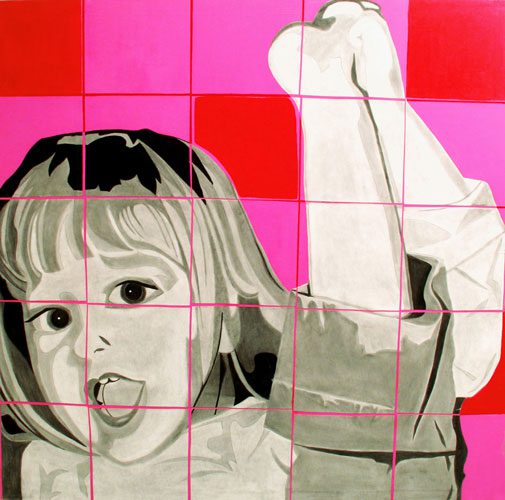
66” x 66”
“On the morning of April 3rd, 2008, 14-month-old Alexis was violently shaken and thrown by her day care provider causing a traumatic brain injury. After 10 days in a coma, Alexis slowly awoke, lacking any abilities she had prior to her injury. She was blind, unable to talk, had no ability to move her arms or legs, eat, or drink. Doctors predicted she would have nothing more than the capabilities of an infant for the rest of her life. After nearly 2,000 hours of rehabilitation, Alexis is thriving despite her disability. She is an outgoing, happy, determined, and increasingly independent five-year-old. Her eyesight has almost completely returned, her speech is ahead of normal children her age, and she walks everywhere with the assistance of a walker. Alexis’ parents believe her traumatic brain injury has shaped her personality, which brightens every room she enters. Her intense dedication to recovery inspired comedian Larry the Cable Guy to donate $1.2 million in 2009 to build a new facility in Lincoln, Nebraska, named the Alexis Verzal Children’s Rehabilitation Hospital at Madonna.” —Tiffany Verzal
ELIETTE MARKHBEIN is the founder of the Therapeutic Arts Program, an Art in Medicine Program serving the TBI population. Eliette is formally trained in Studio Arts, as well as Neuro Art Therapy and Rehabilitation Psychology.
Highlighted in Frontispiece Spring 2012 – Volume 4, Issue 2

Leave a Reply